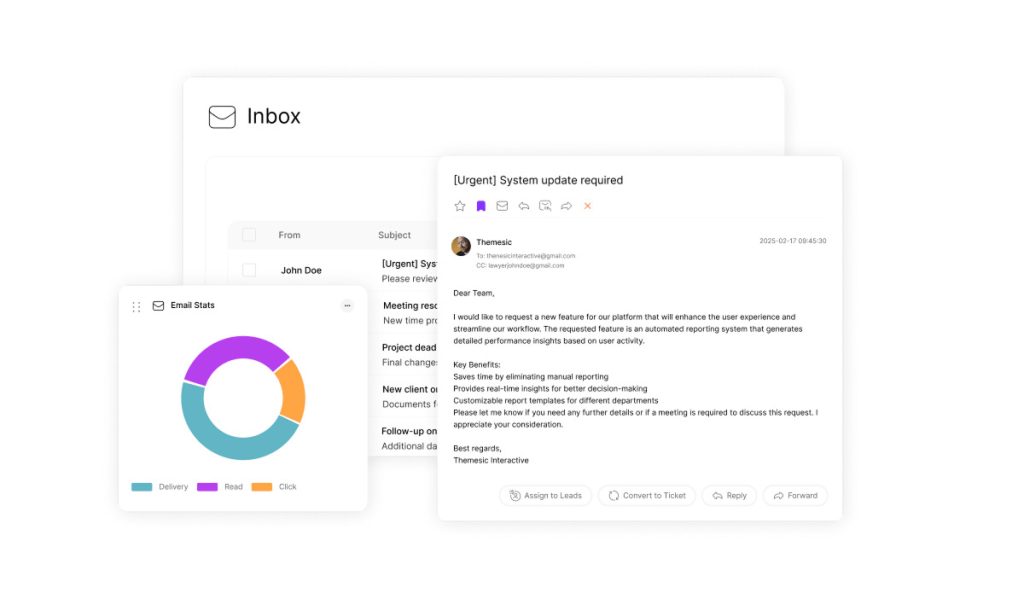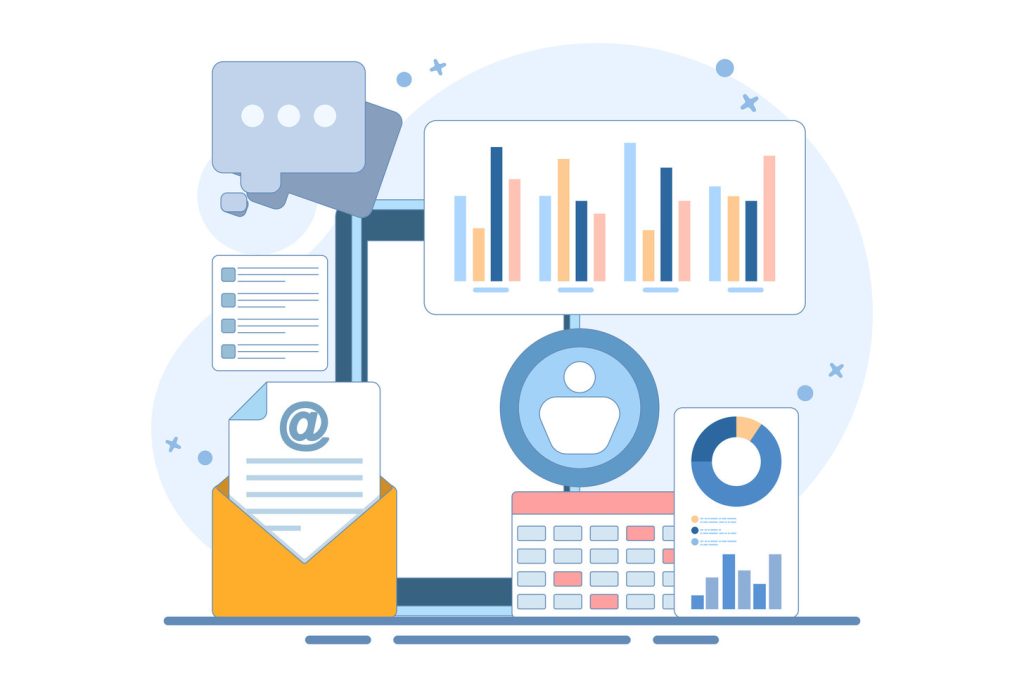Email Tracking Alerts: A Comprehensive Buyer’s Guide

In today’s hyper-digital business landscape, email tracking tools have become essential for understanding customer behavior and boosting engagement. With over 350 million business emails sent daily, modern organizations need advanced email tracking solutions like ClearCRM that go beyond basic delivery confirmations. Email tracking alerts now offer critical insights into email opens, link clicks, replies, and user activity—providing real-time data to empower smarter follow-ups and targeted outreach.
Sales teams, marketers, and recruiters increasingly rely on these tools to identify high-intent recipients, boost open rates, and convert clicks into action. By integrating with ClearCRM and marketing platforms, tracking software aligns team efforts and improves pipeline visibility.
Key Takeaways
- Global email volume exceeds 350 million daily messages, creating demand for advanced engagement analytics
- Modern tracking solutions offer strategic insights beyond basic open/read notifications
- Sales and recruitment teams achieve 34% faster response times using real-time interaction data
- Effective platforms integrate with existing workflows while maintaining strict data privacy standards
- Businesses that optimize communication timing see 22% higher customer retention rates
Introduction to Email Tracking Alerts
Modern organizations face a critical challenge: transforming routine messages into strategic assets. Communication monitoring tools provide actionable insights that reveal recipient behavior patterns, turning ordinary correspondence into measurable business outcomes.
Understanding the Value of Engagement Analytics
Advanced systems integrate directly with platforms like Gmail and Outlook through secure APIs. This connection delivers real-time data on message opens, link clicks, and document views. “The right insights at the right moment transform how teams prioritize outreach,” notes a digital communication strategist.
Businesses gain competitive edges by identifying peak engagement times. Sales teams using these analytics achieve 34% faster response rates through optimized follow-up timing. Marketing departments refine campaigns based on precise interaction metrics rather than assumptions.
Strengthening Professional Relationships Through Data
Personalization drives relationship growth. Monitoring tools help tailor content frequency and formats to individual preferences. A recruiter might adjust follow-up strategies when seeing candidates revisit offer details multiple times.
Key benefits include:
- Enhanced response rates through behavior-based timing
- Improved conversion metrics via content optimization
- Stronger client retention through personalized engagement
These solutions integrate smoothly with existing workflows, transforming standard communications into strategic touchpoints. Organizations report 22% higher satisfaction scores when aligning outreach with recipient behavior patterns.
Key Features and Capabilities of Email Tracking Tools

Sophisticated message analysis platforms transform how teams measure outreach effectiveness. These solutions capture critical interaction data through discrete methods, delivering insights that refine communication strategies across industries.
Message Open Verification and Instant Alerts
Invisible pixel technology confirms when recipients view content, eliminating guesswork about delivery success. Real-time alerts activate within seconds of engagement, enabling teams to capitalize on peak interest moments. Sales professionals using these systems achieve 41% faster follow-up responses compared to manual methods.
- Discreet tracking pixels generate open-rate metrics without disrupting user experience
- Instant alerts via desktop/mobile apps enable strategic response timing
- Geolocation data reveals optimal contact windows across time zones
Content Interaction and Document Analytics
Advanced systems track which links attract attention and how often attachments get reviewed. This intel helps teams identify high-value content and adjust resource allocation. “Seeing which proposals get downloaded repeatedly changes how we prioritize client conversations,” explains a financial services manager.
- Heatmaps visualize engagement patterns within messages
- Attachment analytics show document review duration and frequency
- Customizable reports highlight conversion-driving elements
Leading platforms integrate with popular productivity suites, ensuring seamless adoption into existing workflows. Compliance features automatically redact sensitive data and maintain audit trails for regulated industries.
Email Tracking Metrics Every Business Should Monitor

Metrics transform communication strategies from guesswork to precision-driven operations. Organizations now measure success through quantifiable indicators that reveal audience behavior and content effectiveness. These insights drive smarter resource allocation and campaign optimization.
Open Rates and Click-Through Rates
Open rates remain the cornerstone of outreach analysis. They show how subject lines and sender credibility influence initial engagement. Marketing teams achieving 40%+ open rates typically use personalized preview text and urgency-driven phrasing.
| Metric | Primary Insight | Optimization Focus |
|---|---|---|
| Open Rate | Subject line effectiveness | A/B testing, sender reputation |
| Click-Through Rate | Content relevance | Call-to-action placement, link value |
“Our click-throughs doubled when we aligned links with recipient pain points,” shares a SaaS marketing director. Monitoring these metrics helps teams refine messaging at critical touchpoints.
Engagement and Conversion Benchmarks
Beyond initial opens, advanced analytics track how audiences interact with content. Key indicators include:
- Average read time per message
- Attachment download frequency
- Forward/share rates
Conversion tracking ties these interactions to business outcomes. Teams identify which content drives purchases or meeting bookings. Bounce rate monitoring (keep under 2%) ensures list hygiene, while response time analysis streamlines communication workflows.
Comparing Top Email Tracking Alerts Tools for Gmail and Outlook
Business teams face distinct challenges when selecting communication analytics tools tailored to their primary platforms. With Gmail and Outlook dominating 72% of corporate messaging, specialized solutions address unique workflow needs while delivering precise engagement metrics.
Gmail-Focused Engagement Solutions
Mailsuite simplifies open confirmation through color-coded checkmarks visible directly in the inbox interface. Its browser extension requires minimal setup, making it ideal for fast-paced sales environments. For Gmail users needing deeper insights, Staffbase offers template libraries and scheduling tools alongside real-time read receipts.
Platforms like Mixmax bridge the gap between outreach and CRM management. One sales director notes: “Seeing Salesforce updates trigger automatically after link clicks cut our follow-up time by half.” Streak’s pipeline visualization stands out for teams managing complex deal cycles within their inbox.
Outlook-Based Integration Options
Microsoft-centric organizations benefit from tools like ReadNotify, which maps recipient locations and device types. Yesware enhances Outlook’s native features with team performance dashboards and attachment analytics. Its templated follow-ups reduce repetitive tasks for enterprise sales groups.
- SalesHandy automates reminder sequences based on document engagement patterns
- Mailsuite’s Outlook version maintains consistent tracking across desktop/mobile
- Platform-specific optimizations preserve existing keyboard shortcuts and folder structures
These solutions demonstrate how tailored tracking software adapts to organizational ecosystems rather than forcing workflow changes. Decision-makers should prioritize tools offering native integrations with their team’s daily operations.
Integrating Email Tracking with CRM and Marketing Platforms

Seamless integration between communication tools and business platforms reshapes how organizations leverage customer interactions. By merging engagement data with existing systems, teams unlock strategic advantages that drive measurable outcomes.
Benefits of Combining Email and CRM Data
Linking communication analytics to CRM systems transforms raw metrics into actionable intelligence. Customer profiles evolve with details like preferred contact times and content types. Sales teams using integrated platforms report 28% faster deal cycles through automated lead scoring based on engagement patterns.
Platforms like Email Meter bridge data collection with execution. Real-time dashboards track response rates and service-level agreements, while consolidated reports highlight team performance gaps. “Our CRM now triggers follow-ups when prospects revisit proposals,” shares a retail account manager.
Optimizing Email Communication Strategies
Marketing teams gain precision by aligning outreach analytics with campaign tools. Synchronized data reveals which messages influence purchase decisions or webinar registrations. Automated workflows adjust content delivery based on recipient behavior—sending nurture sequences after document downloads or meeting invites following link clicks.
Key integration advantages include:
- Unified customer journey maps combining email interactions with social media engagement
- Dynamic content recommendations powered by historical response data
- ROI calculations connecting specific messages to closed deals
Organizations using these combined systems achieve 19% higher campaign conversion rates. Decision-makers access holistic performance metrics, eliminating guesswork from strategy adjustments.
Email Tracking Software and API Options
Organizations face strategic decisions when adopting message intelligence systems. Two distinct approaches emerge: pre-built platforms for rapid deployment and customizable APIs for tailored functionality. The optimal choice depends on technical resources, scalability needs, and integration requirements.
Plug-and-Play Business Solutions
Ready-made platforms like HubSpot Sales Hub offer instant functionality with intuitive dashboards. These systems typically feature:
- One-click integration with popular productivity suites
- Preconfigured analytics for common use cases
- Automatic updates maintaining compliance standards
“Our sales team activated tracking capabilities within 15 minutes,” reports a retail operations manager using Mailtrack. Cloud-based solutions scale automatically, handling message volumes from 100 to 100,000+ monthly sends without infrastructure changes.
Tailored Development Through APIs
For organizations needing specialized functionality, APIs provide granular control. Nylas’ solution connects with every major provider through secure protocols. Key advantages include:
| Factor | Pre-Built Software | Custom API |
|---|---|---|
| Implementation Time | Instant | 2-6 weeks |
| Monthly Cost | $15-$50/user | Usage-based pricing |
| Customization | Limited | Full control |
Technical leaders emphasize API flexibility.
“We built unique analytics that align with our client support workflows,”
Decision-makers should evaluate team expertise and long-term goals when choosing between rapid deployment and bespoke development. Robust documentation and responsive technical support prove critical for both approaches.
Enhancing Sales and Communication Through Email Metrics

Strategic use of communication metrics revolutionizes how teams convert conversations into revenue. Organizations now harness detailed interaction data to refine outreach sequences and maximize deal closure rates.
Transforming Productivity Through Behavioral Insights
Sales teams achieve 41% faster conversions by aligning follow-ups with recipient activity patterns. Platforms like Email Meter identify peak engagement windows and message overload scenarios. Real-time analytics reveal which prospects repeatedly open proposals or share content with decision-makers.
Key advantages include:
- Priority lead identification through document review duration tracking
- Automated alerts for urgent replies needed in lengthy threads
- Performance dashboards comparing individual and team response metrics
“Our sales cycle shortened by 19 days once we acted on attachment engagement data,” notes a tech sales director. Teams eliminate guesswork by setting measurable goals for response times and conversation rates.
Collaboration metrics expose workflow bottlenecks. Managers spot departments drowning in redundant messages or missing critical follow-ups. Centralized tracking capabilities help redistribute workloads and synchronize cross-team efforts.
Organizations using these insights report:
- 27% reduction in internal communication clutter
- 34% faster client issue resolution
- 22% higher lead-to-customer conversion rates
ROI calculations become precise when connecting specific messages to closed deals. Businesses optimize content strategies based on proven engagement patterns rather than assumptions.
Conclusion
In today’s data-driven marketplace, communication analytics redefine how businesses measure outreach success. Email tracking solutions bridge the gap between routine correspondence and strategic relationship-building, delivering measurable value across sales pipelines and client interactions. The right tool transforms raw metrics into competitive advantages – whether through instant deployment or customized API integrations.
Organizations achieve maximum impact by aligning platform selection with operational needs and growth trajectories. Teams prioritizing CRM synchronization and behavioral insights see 27% faster decision-making cycles. Scalable software adapts as communication strategies evolve, ensuring long-term relevance without workflow disruptions.
Successful implementation hinges on balancing immediate functionality with future-proof adaptability. Businesses that master this equilibrium report 19% higher customer retention and 34% improved team productivity. When integrated with marketing ecosystems, these platforms create closed-loop systems where every interaction fuels smarter outreach.
The future belongs to organizations treating messages as actionable intelligence. By choosing solutions that grow with their ambitions, leaders turn everyday communications into engines for sustainable growth.

